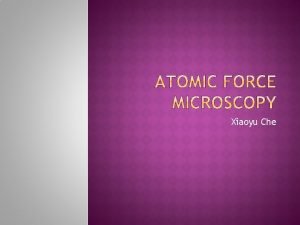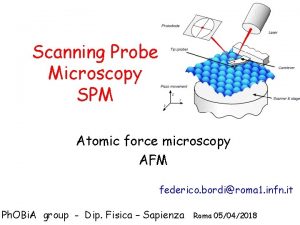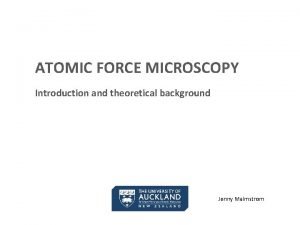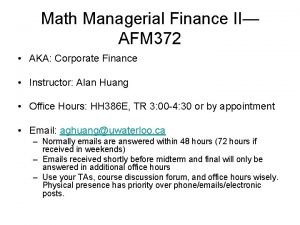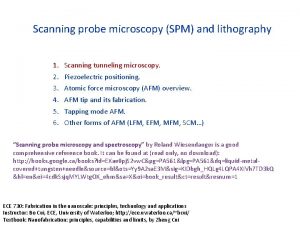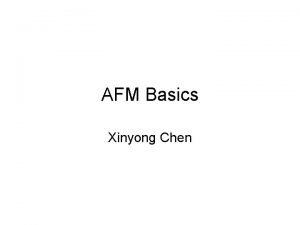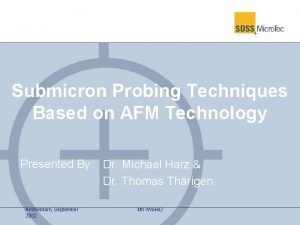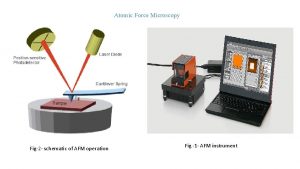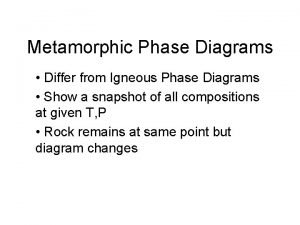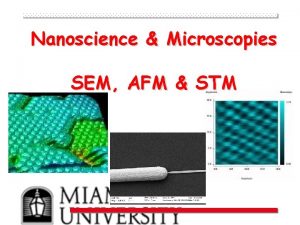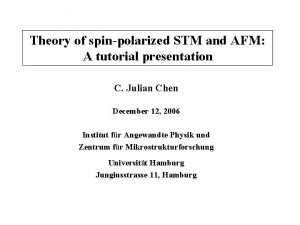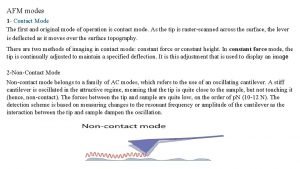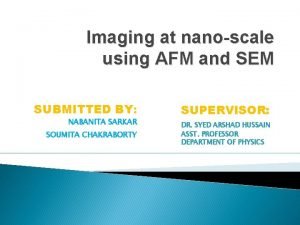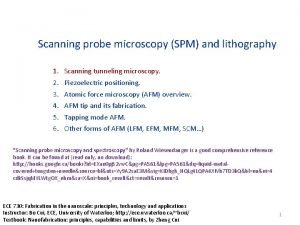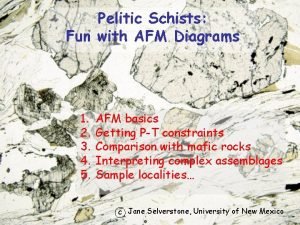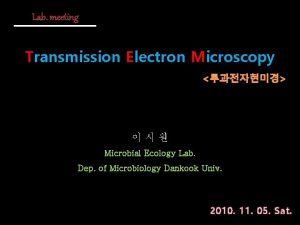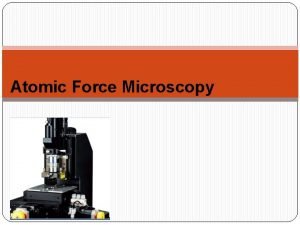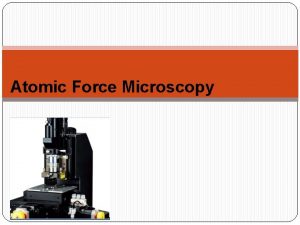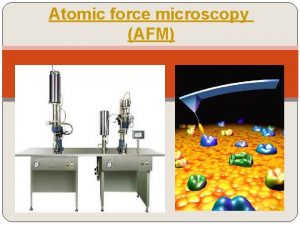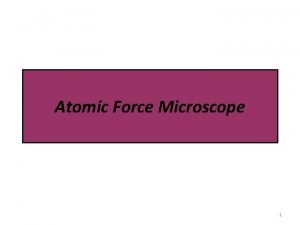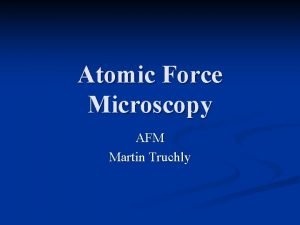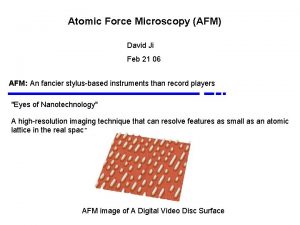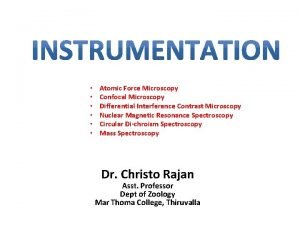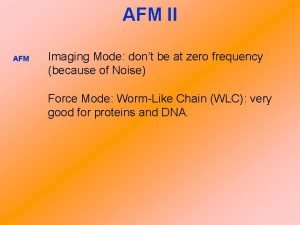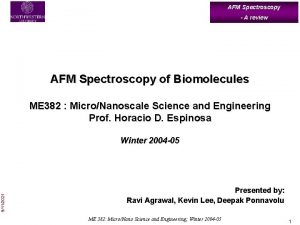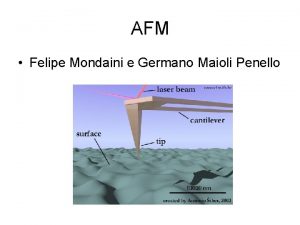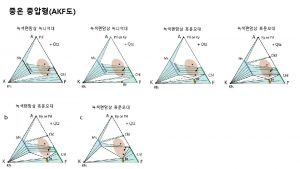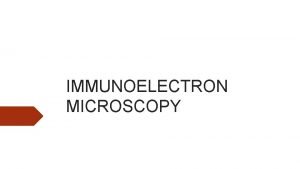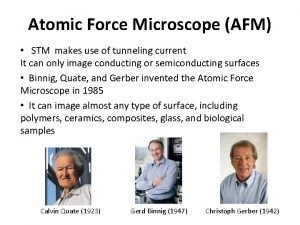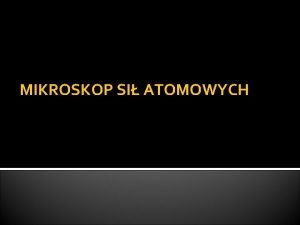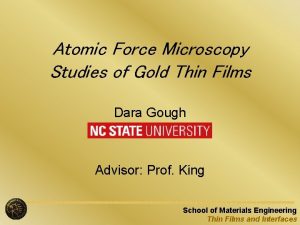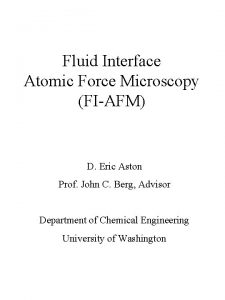Atomic Force Microscopy Atomic force microscopy AFM is

























- Slides: 25

Atomic Force Microscopy

Atomic force microscopy (AFM) is a very-high- resolution type of scanning probe microscopy(SPM), with high resolution on the order of fractions of a nanometer, more than 1000 times better than the optical microscopy. The information is gathered by "feeling" or "touching" the surface with a mechanical probe.

Background and History 1981 – Swiss scientists Gerd Binnig and Heinrich Rohrer- Atomic resolution microscopy, simple 1986 – Nobel prize

General Applications 1 Materials Investigated: Thin and thick film coatings, ceramics, composites, glasses, synthetic and biological membranes, metals, polymers, and semiconductors. 2 Used to study phenomena of: Abrasion, corrosion, etching (scratch), friction, lubricating, plating, and polishing. 3 AFM can image surface of material in Nano resolution and also measure force at the nano- scale.

Further Applications

Parts of AFM 1. Laser (Illumination)– deflected off cantilever 2. Mirror –reflects laser beam to photo detector 3. Photo detector –dual element photodiode that measures differences in light intensity and converts to voltage 4. Amplifier- amplifies the signal 5. Recorder 6. Sample 7. Probe –tip that scans sample made of Si 8. Cantilever –moves as scanned over sample and deflects laser beam


Principle The AFM consists of a cantilever with a sharp tip (probe) at its end that is used to scan the specimen surface. The cantilever is typically silicon or silicon nitride with a tip radius of curvature on the order of nanometers. When the tip is brought into proximity of a sample surface, laser beam activates the forces between the tip and the sample lead to a deflection of the cantilever. Depending on the situation, forces that are measured in AFM include mechanical contact force, van der Waals forces, capillary forces, chemical bonding, electrostatic forces. 8

How Does AFM Work?


Scanners AFM scanners are made from piezoelectric material, which expands and contracts proportionally to an applied voltage. Peizo electric material- Barium titanate, Zirconium titanate Whether they elongate or contract depends upon the voltage applied. Traditionally the tip or sample is mounted on a 'tripod' of three piezo crystals, with each responsible for scanning in the x, y and z directions. Because of differences in material or size, the sensitivity varies from scanner to scanner.

Experimental Procedures Sample preparation Thin layer of wax on steel disk Measuring 3 -D Imaging Manipulating/Analyzing

Diagram Measuring -3 D Imaging Analysing

Scanning the Sample/measure Tip brought within nanometers of the sample (Van der Waals) Radius of tip limits the accuracy of analysis/ resolution Stiffer cantilevers protect against sample damage because they deflect less in response to a small force

Data Analysis Morphology Characterization/ Sub microscopic level Surface roughness quantification Physical properties/ Swelling, cohesiveness, smoothness Will be analyzed

AFMTips FIB- Focused ion beam

THREE Modes: Contact mode, Non-contact, mode, Tapping Mode A. Contact Mode; hard, stable samples in air or liquid B. Non-Contact Mode: non- invasive sampling. C. Tapping (Intermittent contact): No shear and damaging samples

A. Contact Mode � Measures repulsion between tip and sample � Force of tip against sample remains constant � Problems: applied excessive tracking forces by probe to sample- sample will destroy.

B. Non-Contact Mode � Measures attractive forces between tip and sample � Tip doesn’t touch sample � Van der Waals forces between tip and sample detected � Problems: Can’t use with samples in fluid � Used to analyze semiconductors � Doesn’t degrade or interfere with sample- better for soft samples

C. Tapping (Intermittent- Contact) Mode � Tip vertically oscillates between contacting sample surface and lifting of at frequency of 50, 000 to 500, 000 cycles/sec. � Oscillation amplitude reduced as probe contacts surface due to loss of energy caused by tip contacting surface � Advantages: overcomes problems associated with friction, adhesion, electrostatic forces � More effective for larger scan sizes


Advantages and Disadvanteges of AFM

In general

The future of AFM Sharper tips by improved micro-fabrication processes: (tip – sample interaction tends to distort or destroy soft biological molecules ) development of more flexible cantilever springs and less damaging and non-sticky probes needed

Nano-Identification on Fiber surface Cotton Viscos e Rayon MMF
 Magnetic force microscopy data recovery
Magnetic force microscopy data recovery Afm
Afm Afm welfare
Afm welfare Spm afm
Spm afm Afm modes of operation
Afm modes of operation What is afm math
What is afm math Afm mfm tutorial
Afm mfm tutorial How afm works
How afm works Afm teknoloji
Afm teknoloji Afm schematic
Afm schematic Istituto deffenu olbia
Istituto deffenu olbia Metamorphic rocks phase diagram
Metamorphic rocks phase diagram Block diagram of sem
Block diagram of sem Stm tutorial
Stm tutorial Afm contact mode
Afm contact mode Itc baggi sassuolo
Itc baggi sassuolo Afm
Afm Scanning probe microscopy applications
Scanning probe microscopy applications Geologia
Geologia Atomic number vs atomic radius
Atomic number vs atomic radius Trend of ionic radius
Trend of ionic radius Difference between atomic mass and mass number
Difference between atomic mass and mass number Is atomic mass and relative atomic mass the same
Is atomic mass and relative atomic mass the same Differentiate between atomic number and mass number
Differentiate between atomic number and mass number Periodic trneds
Periodic trneds Microscopy tutor
Microscopy tutor

